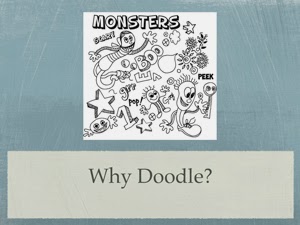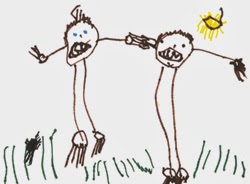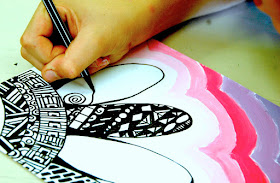How can we afford to "waste" valuable time in our classrooms letting our students doodle?
Sunny Brown gives the current definition of “doodle” in her TED talk, “Doodlers, unite!”:“In the 17th century, a doodle was a simpleton or a fool, as in “Yankee Doodle.” In the 18th century, it became a verb, and it meant to swindle or ridicule or to make fun of someone. In the 19th century, it was a corrupt politician. And today, we have what is perhaps our most offensive definition, at least to me, which is the following: “To doodle officially means to dawdle, to dilly dally, to monkey around, to make meaningless marks, to do something of little value, substance or import and,” my personal favorite, “to do nothing.” No wonder people are averse to doodling at work."
However before a child can speak, they can draw pictures. Drawing helps children understand the world around them and helps them to make sense of the world. When children draw, it is without fear of what others will think, or to try to make a perfect representation of their world, but rather an attempt to communicate and understand what is going on around them. Here's a drawing of friends by a young student.
To take it one step further, the beginning of humankind first communicated through the use of cave paintings and we've learned more about that time from their artwork than in any other way.
So why spend valuable class time doodling?
Doodling greatly benfits our students and gives voice to learners who learn visually. According to Linda Silverman, director of both the Institute for the Study of Advanced Development and the Gifted Development Center and author of Upside-Down Brilliance: The Visual-Spatial Learner, 37% of the population are visual learners.Doodling helps students retain information. When students read a story or listen to a lecture and doodle their understanding of that information their retention is increased.
As Sunni Brown states further in her TED talk, re-defining what doodling is:
“Doodling is really to make spontaneous marks to help yourself think. That is why millions of people doodle. Here’s another interesting truth about the doodle: People who doodle when they’re exposed to verbal information retain more of that information than their non-doodling counterparts. We think doodling is something you do when you lose focus, but in reality, it is a preemptive measure to stop you from losing focus. Additionally, it has a profound effect on creative problem-solving and deep information processing.”In the arts, it allows students to draw without fear of failing and helps them to find their own artistic voice.
It uses abstract thinking skills. With the institution of the common core and it's emphasis on the higher level thinking skills, this is a valuable opportunity for students to use those skills.
How can teachers integrate doodling in the classroom?
Integrating doodling into the classroom isn't as hard as you might think. In Language Arts students can be asked to finish a doodle starter and then write about what they've drawn. I have a doodle starter lesson for elementary classroom teachers.When reading a book for class the students can use post-it notes to doodle their ideas or thoughts as they are reading. This allows them to have a better understanding and recall of the story when they are done.
If you click on the image below it will take you to a great blog that explains SketchNotes in a visual way!
I also teach a doodling lesson in my visual arts class. Here are some pictures of my students working on a more structured doodle lesson, Doodle Landscapes:
Another activity that would be fun for students is to draw flowers, or bugs and then doodle inside the shapes! What a fun, simple craft to celebrate the coming of Spring! Here's a fun blog with step by step instructions on creating zentangle flowers! Check it out by clicking on the image!
You can find lots of great zentangle patterns on pinterest. Here is a board with some zentangle ideas and step by step patterns!
Doodling for fun is a great way to get students warmed up and get their creative juices flowing. The video I put together using visuals of different doodles is free. Access FREE video by clicking on the picture below.
21st Century Skills
Doodling is about using visual skill to solve problems. Creative problem-solving is one of the most important 21st century skills that our students will need to succeed. Best of all, no student ever complains that the day was horrible because they had to doodle! So can you tell I'm into doodling?! Lol! Take a chance and let your students amaze you with their creativity. Start doodling in your classroom! I'm sure many of you incorporate doodling into your classrooms already, how do you do it?
So go ahead, start doodling!
















I am excited to try this out with my son! Thanks for the suggestion :)
ReplyDelete